This guide takes a look at the different types of stablecoins in the cryptocurrency market and its importance in the most volatile trading environment.
Centralization runs deep in our society in the form of corporations, businesses and governments. Not that they’re bad, but blockchain technology can offer a viable structural alternative through creating a more transparent and accountable system. The idea of open-source decentralization is to redistribute power and to create a fair and trustless system across all industries. This technological breakthrough therefore brings lots of promise and hope for our future.
Cryptocurrencies: The Most Volatile Asset You Can Find
Despite this revolutionary solution, cryptocurrencies are still struggling to be widely adopted. For one, cryptocurrencies are extremely volatile with prices fluctuating rapidly and unpredictably. Given the infancy of the technology, some reckon that there is still a long way to go before cryptocurrencies can become a viable and practical medium-of-exchange. Currently, a major attribute giving rise to this extreme volatility is speculation; demand for cryptocurrencies are fuelled by trading and speculation rather than real-world adoption.
We can see the effect of this, when the general market capitalization of cryptocurrencies hit an all-time high of over $800 billion at the start of 2018 but is currently at its lowest level of a mere $200 billion half a year later.
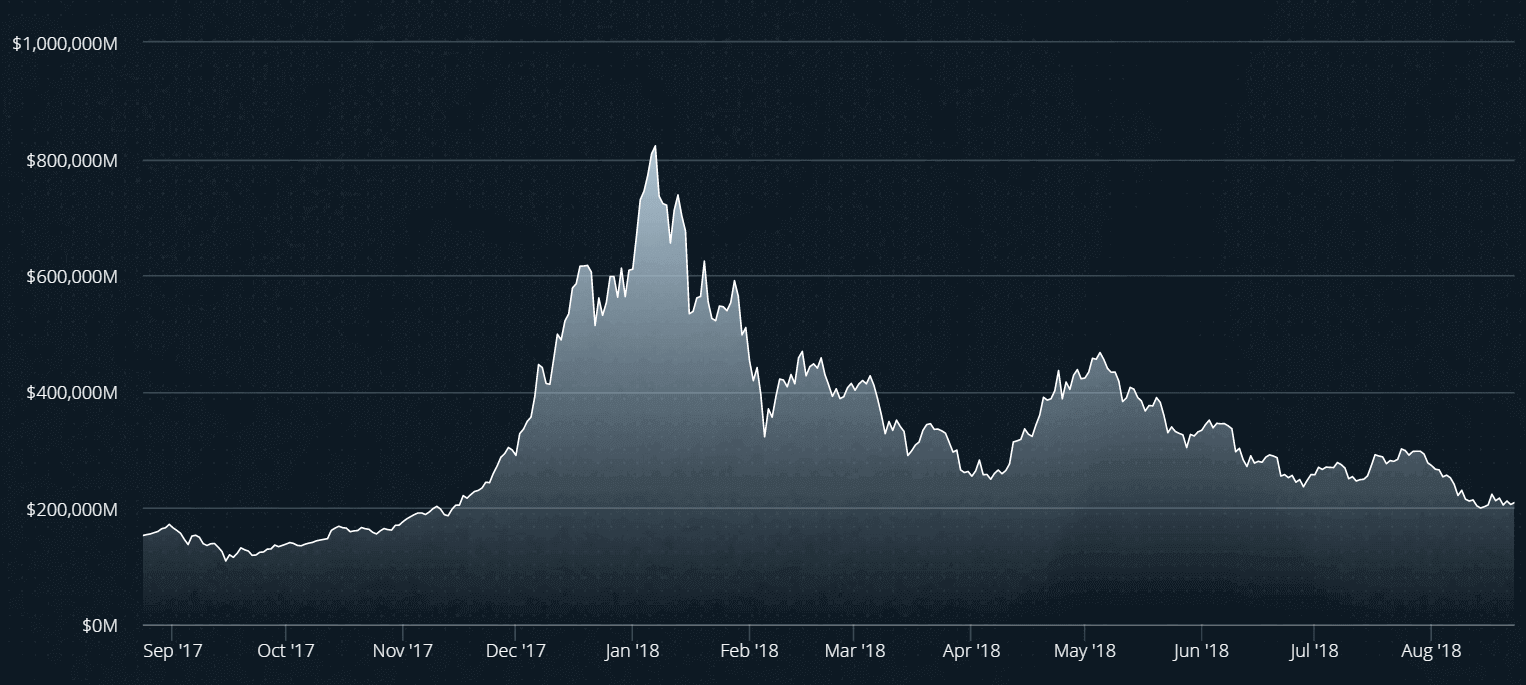
In fact, coins are down an average of 80% since their all-time highs, which further reinforces the extreme volatility of cryptocurrencies. They are struggling to maintain their valuation against the US dollars. Considering cryptocurrencies’ extremely volatile nature, it would be hard to use cryptocurrencies to transact and the majority of retail merchants – which represent an important group that affects cryptocurrency acceptance – are aware of this. In order to alleviate the volatility of the cryptocurrency market, different variations of stablecoins have been introduced.
(See more: Bitcoin vs Alt Coins Returns: Comparison of Gains Between Bitcoin & Altcoins Investing)
What is a Stablecoin?
Stablecoin – as the name suggests – is a cryptocurrency which is pegged to an asset with a stable value, such as gold or fiat money (USD specifically). A stablecoin usually has a fixed valuation in relation to its underlying asset. For example, Tether (USDT) is backed by USD dollars and has a stable value of USD $1 for each USDT token. A stablecoin should always remain stable in its value despite the crazy volatility of other cryptocurrencies.
It is no surprise that cryptocurrencies are the most volatile asset (or investment) that you can come across; the general cryptocurrency market capitalization can increase or decrease in double digits in just a single day. Stablecoins on the other hand, have a fixed value relative to the underlying asset. There are different categories to stablecoins that we will explore below.
(Read also: Coins, Tokens & Altcoins: What’s the Difference?)
Importance of Stablecoins
Without both short-term and long-term stability, it is considered extremely risky for the mainstream public to adopt cryptocurrencies as a direct replacement for fiat or traditional assets. Larger mass adoption will always require some form of stability. From a consumer perspective, it’s risky and impractical to use cryptocurrencies for daily use. A volatile medium of exchange can compromise users' purchasing power.
Purchasing power refers to the financial ability of purchasing products and services. It is used to describe the quantity of goods and services that can be purchased with a single unit of currency. For instance, USD $1 would allow us to buy a simple cup of coffee today and perhaps, a year from now. But buying that same cup of coffee using $1 would be vastly different from now, since the value of Bitcoin fluctuates wildly. Perhaps it can get you half a cup of coffee next year or even 100 cups of coffee.
That’s where stablecoin comes into play. Stablecoins are the only form of cryptocurrencies where you don’t have to worry about instability and volatility of cryptocurrency prices. Stablecoins have an important role due to the following factors:
-
Alleviate Economic & Political Hardship
Stablecoins have the potential to help people living in countries suffering from high inflation rates, which ultimately reduces their purchasing power. This is usually a result of economic and political uncertainty. There are many examples throughout history where fiat money has significantly suffered from devaluation, with the most recent example being Venezuela’s national currency, which has devalued by over 95%! This means that if previously a cup of coffee were to cost VEB $1, you now need VEB $20 to buy that same cup of coffee since its value has diminished!
In these countries, it is extremely hard to move their capital elsewhere since capital control laws are imposed by the government to prevent money from leaving the country. Converting their money in stablecoins will ensure that the value of their money is preserved, instead of keeping their money in their national fiat currency which will further reduce their purchasing power. Stablecoins have the ability to globally assist the masses from the fallout of economic and political uncertainty.
(Read also: Guide to Cryptocurrency Taxes: A Guide to Common Tax Situations)
-
Hedging Mechanism for Traders
Hedging – or ‘hedge’ – simply means to reduce the risk of adverse price movements in an investment or asset. Hedging is a strategy often used in the investment world to protect your positions by reducing risks. There are many ways to reduce risks, such as having a balanced portfolio mix of ‘safe’ and ‘risky’ investments.
Stablecoins are commonly used in the cryptocurrency market as a hedge against Bitcoin (BTC) and other top altcoins. Many cryptocurrency traders (mostly short-term traders) sell their cryptocurrencies for stablecoins if they think that there’s impending news that will reduce the general cryptocurrency prices. Converting their holdings into stablecoins protects their value. Looking at monthly volume rankings, you can observe that Tether (USDT) has the second highest trading volume, only second to bitcoin. USDT is the most popular stablecoin on the market that is most commonly used by the community to hedge their positions.
USDT is primarily used by short-term crypto traders to reduce risks without actually ‘cashing out’ or moving your money back to your bank account. Moving your money back to your bank account requires a significant amount of time, sometimes hours or even days before you can re-deposit your money back to cryptocurrency market. Stablecoins streamline this process by having a tokenized option of preserving your value in USD.
(See more: Crypto Beginners Guide: 5 Things Crypto Newbies Should Know)
Categories of Stablecoin
There are a wide variety of stablecoins in the cryptocurrency market which are generally divided into 4 main categories.
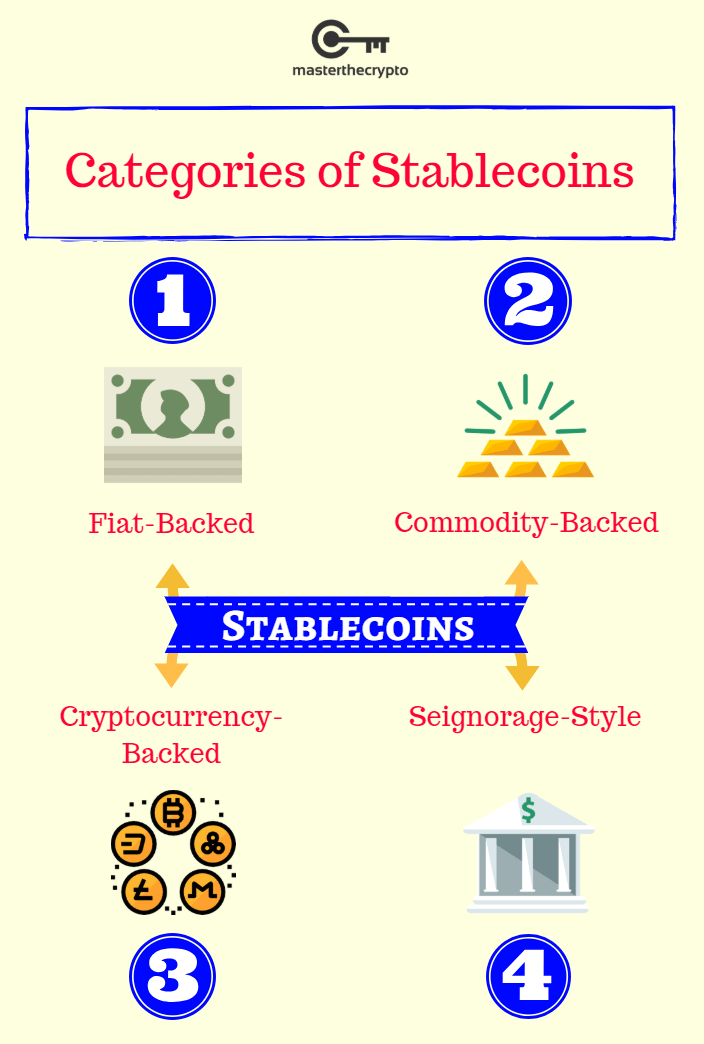
1. Fiat-Backed Stablecoin
This is the common form of stablecoins. Fiat-backed stablecoin are coins that are fully backed by fiat money.
Fiat money is the national currency of a country that issues it. In other words, it’s the paper money in your wallet and the digital money in your bank account. Examples of fiat money include USD, EUR, CHF, GBP and JPY.
Fiat-backed stablecoins are backed 1:1, meaning $1 of stablecoins is equivalent to $1 of fiat money. The idea is that their stablecoin is ‘backed’ by real fiat in real bank accounts. This category of stablecoins is indeed the most simple but also the most centralized. Here is a diagram showing how it works:
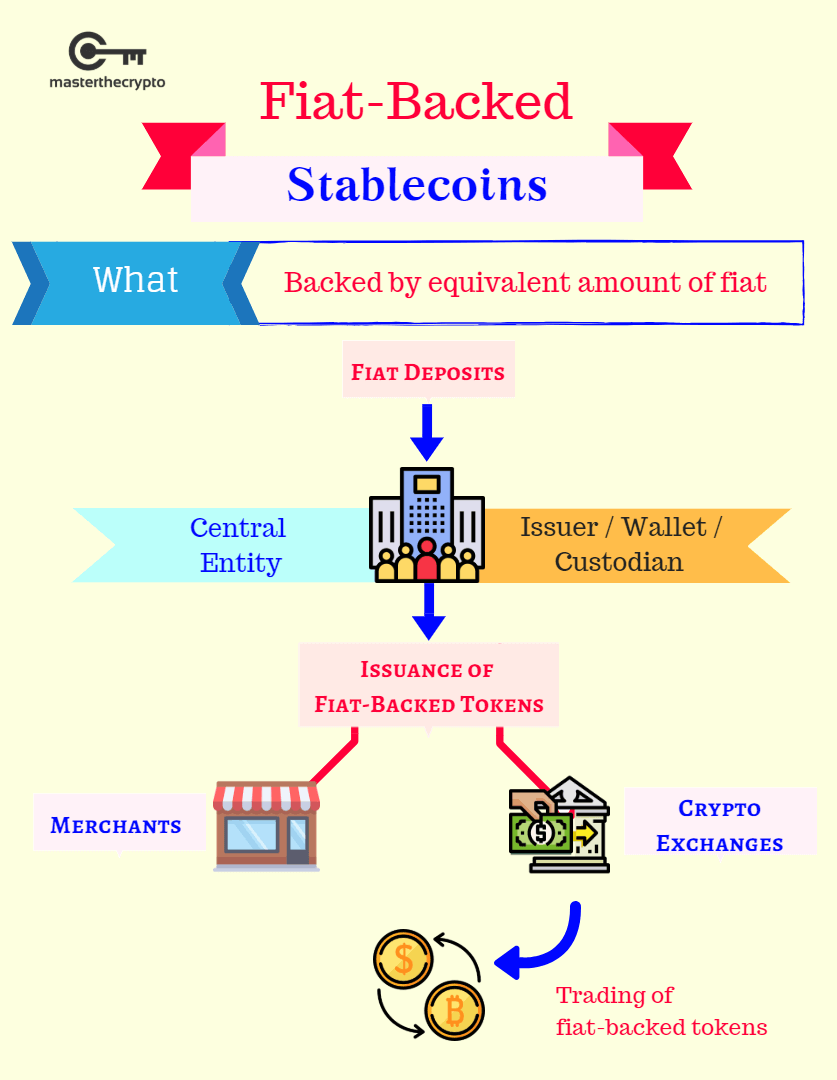
As you can see, there will be a company or central entity that will manage the acceptance of new fiat and issues a corresponding amount of fiat-backed tokens. The company is the custodian of the fiat reserves that backs all the tokens. This centralized structure requires a degree of trust – through third-party audits – in verifying and validating that the fiat reserves fully correspond to the token supply. Whenever a holder wants to redeem cash with his tokens, the company will wire transfer the fiat money to the holder’s bank account and the equivalent coins will be destroyed or taken out of circulation.
Advantages
- Simple: The fiat-backed structure is easy to understand and straightforward
- Stability: Fiat currencies are a stable asset since it is (legally) backed the government and the economy of the country. This ensures that the underlying prices wouldn’t fluctuate much
Disadvantages
- Centralized: This is a centralized structure that is prone to various vulnerabilities and risks, such as a single point of failure, bankruptcy of the central entity and moral hazards
- Requires Trust: The central entity needs to be trusted for the fully-functioning of the system, which goes against the principle of cryptocurrencies. External audits need to be carried out to verify the credibility of accounts.
- Regulations: Fiat-involving processes would require greater oversight and regulations, which could compromise the efficiency of the conversion process
Here are some examples of fiat-backed stablecoins:
Tether (USDT)
Tether is backed by the US dollars (USD) and represents the most popular stablecoin with huge daily volume. Tether is issued by a company called Tether Limited, which has close links to Bitfinex exchange, the 3rd biggest exchange in terms of daily trading volume. In fact, they share the same CEO. Tether is mainly used as a tool for hedging by cryptocurrency traders whenever there’s looming bad news for the markets. An example was when the SEC rejected Bitcoin ETF’s proposal from Winklevoss Brothers; many traders sold their cryptocurrencies for Tether in order to preserve their investment value. Tether provides a way for traders to convert their holdings into the equivalent of USD value, without the inefficiencies of having to actually ‘cash-out’ in real USD.
Controversies
However, there are some controversies surrounding Tether as there is a lack of transparency in whether USDT is fully backed by the equivalent fiat reserves. While Tether claims that their USD fiat reserves are sufficient to back all the issued USDT tokens on a 1-to-1 basis, many critics have been challenging this claim. Many critics believe Tether company has issued more USDT tokens than its dollar reserves in its bank account. They also claim that Tether management team have been artificially pumping bitcoin price with all the newly printed Tethers.
Despite all of that, it remains one of the most popular cryptocurrencies in the market with a market capitalization of over $2 billion.
(Read more: A Guide To Fundamental Analysis For Cryptocurrencies)
TrueUSD (TUSD)
TrueUSD was created as a more ‘transparent’ alternative to Tether. According to the official website, their legal framework will enable TUSD customers to exchange USD directly through an escrow account, which will never be touched by TUSD team. They utilize smart contracts to ensure the 1:1 parity between their real USD reserve in the escrow accounts and the TUSD tokens issued.
TUSD was first introduced on Bittrex but have expanded into other exchanges that include Binance, CoinTiger, Upbit, and more. TUSD is the second most popular stablecoin in terms of volume. The team at TrueUSD want to expand the utility of TUSD tokens for multiple use cases such as for e-commerce and also a medium for international transfer. TUSD boasts a strong team that is said to contain top talents from Google, Palantir, Berkeley, and even Stanford University.
(See more: Guide on Identifying Scam Coins)
2. Commodity-Backed Stablecoin
This category of stablecoins are backed by commodities. Commodities are fungible assets that are interchangeable for trading in the same market.The most common commodity to be collaterized is gold, which is a form of precious metals.
Gold and commodity-backed money has a long history for being a medium of exchange and a store of value, before being abandoned in the 1970s.
Precious metals such as gold has often been viewed as a good store of value since it retains its value pretty well relative to other assets. That is why investors flock to gold (considered a ‘safe haven) during a market recession where every other asset depreciates.
For gold-backed stablecoin, one coin represents a specific value of gold (for example, 1 token = 1 gram of gold). The physical gold itself is often stored in a trusted third party’s vault. While commodity-backed stablecoins are not as popular as fiat-backed ones, it provides a viable alternative for those who seek to transact in tokens backed by real, tangible value by way of precious metals.
In order to understand the commodity process flow, we’ll take a look at Digix’s gold minting process since it looks like they are (unfortunately) the only credible commodity-backed cryptocurrency:
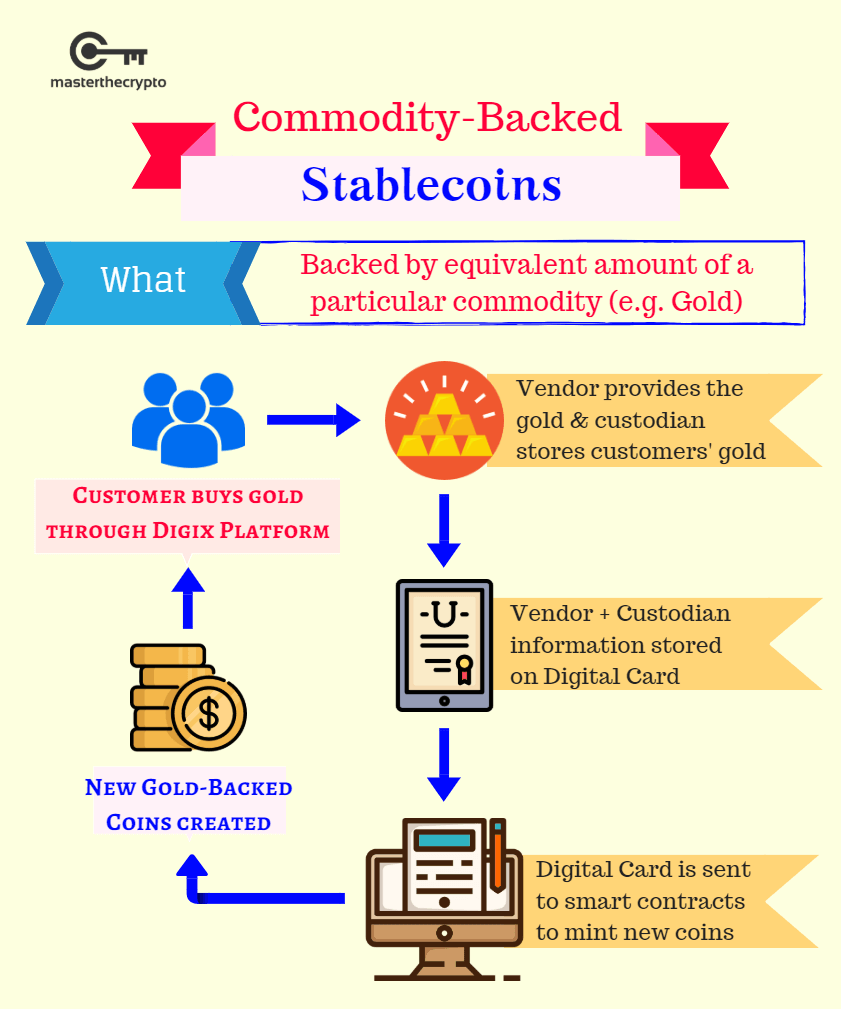
There are also stablecoins that are backed by oil. An example is Petro coin, a coin backed by Venezuela’s oil reserves. However, there are many critics that points to Petro coin being a scam.
Advantages
- Backed by Real Assets: Coin holders have recourse to an asset that is tangible and backed by real value. They can redeem these assets at the conversion rate to take possession of real assets
- Stability: The price of commodities is relatively stable and therefore would represent a good underlying asset for a stablecoin
- Liquidity: The tokenization of commodities brings greater liquidity that facilitates better price discovery
Disadvantages
- Centralized: Third-parties such as the vendors, custodians and the project itself is needed to ensure the full-functioning of the system and increases the risks of a single point of failure.
- Audit: An audit process is an expensive and time-consuming process that underscores the capabilities of a decentralized blockchain.
Here is an example of the biggest commodity-backed stablecoin:
Digix Gold Tokens (DGX)
DGX is am Erc-20 token backed by physical gold that has been fully audited and is stored in a vault in Singapore, known as The Safe House. DGX is fully redeemable at any point of time. The value of each token is fully dependent on the market value of gold. DGX is based on the Proof-of-Provenance algorithm where each gold bar is secured and it's ownership/custodianship status is tracked accurately on the Ethereum blockchain. DGX is scheduled to be audited each quarter (every 3 months), which is a positive indicator.
DGX is created by a company called DigixGlobal. Interestingly, the Digix team created two tokens, Digix Gold Tokens (DGX) and DigixDAO Tokens (DGD). DGD tokens are used as a form of participation in DigixDAO's governance system, in a bid to grow DGX's adoption. Currently, DGX tokens are mainly used as collaterals and trading pairs by other crypto projects, such as MakerDAO, Kryptono Exchange, Kyber Network, WeTrust, Monolith, and others.
The Digix team was formed way back in 2014 and includes the former CEO of Fujitsu Asia, Teo Hye Chng, as their chairman.
(See more: Guide To Cryptocurrency Trading Basics: Do Charts & Technical Analysis Really Work?)
3. Cryptocurrency-Backed Stablecoin
Crypto-Backed stablecoins are coins backed by other digital currencies, usually the top-ranked cryptocurrencies with large market capitalization such as Bitcoin (BTC) or Ether (ETH). Typically, crypto-backed coins are backed by a mix of cryptocurrencies rather than being backed by just a single currency. This allows for better risk distribution; the volatility risks for a single cryptocurrency is much higher than that of a combined group of cryptocurrencies. Furthermore, a stablecoin backed by a single cryptocurrency wouldn't make much sense since cryptocurrencies are extremely volatile and wouldn't make a good store of value.
This is the main reason why crypto-backed stablecoins are often over-collaterized, so that it can withstand the extreme price fluctuations of the underlying cryptocurrencies. The most common form of crypto-backed stablecoins require users to stake (and lock-up) a certain amount of cryptocurrencies into a smart contract which will then result in the creation of a fixed ratio of stablecoins.
Here is the general process:

Advantages
- Decentralization: Adheres to a decentralized structure that is trustless, transparent and secure
- Efficient: Liquidation – or conversion from one crypto to another – occurs quickly since it occurs on the blockchain
- Transparent: Every transaction is recorded on the public blockchain, allowing for full transparency and accountability
- Leverage: Due to the need for over-collatarization, crypto-backed coins can be used to create leverage for trading
Disadvantages
- Volatile: Since the underlying asset is itself a cryptocurrency, it is inherently much more volatile than other assets such as commodities or fiat money
- Instant Liquidation: The underlying cryptocurrency can be instantaneously liquidated if its value falls below a certain threshold
- Complex: There are multiple complex elements that can obfuscate the minting process
Here is a prominent example of a crypto-backed stablecoin:
MakerDAO (DAI)
MakerDAO is an ERC-20 project that has 2 separate coins: MKR & DAI. We will focus on DAI since it is a stablecoinbacked by other cryptocurrencies. Unlike other stablecoins, Dai does not rely on a centralized entity or third party since it lives completely on the blockchain. DAI is a decentralized, cryptocurrency-backed coin with a face value that is pegged to the US dollars. DAI achieves price stability through an autonomous system of smart contracts – called Collateralized Debt Position (CDP) – that responds to varying market dynamics.
In order to create new coins, Ether (ETH) must be used as collaterals and sent to the CDP. The CDP will lock the staked ETH and new DAI’s will be minted. MakerDAO plans to allow for the use of other ERC-20 tokens in the future.
(Read also: Hard Forks in Cryptocurrency: Does it Spell Chaos or Innovation?)
4. Seignorage-Style Stablecoin
Seignorage are the only category of stablecoins which are not backed by any asset. Seignorage-style coins utilize an algorithmically governed approach to expanding and contracting a stablecoin’s money supply, just like how a central bank prints or destroys money. As the total demand for the coins increases, new supply of stablecoins are created to reduce price back to stable levels. The main objective is to get the coin’s price as close as possible to USD $1. Unsurprisingly, seignorage-based stablecoins are not popular but it has gained considerable interests as of late.
Advantages
- Decentralized: Since every adjustments are made on-chain, all data related to the stablecoin is stored in a trustless, transparent and secure ledger
- Absence of Collaterals: No collaterals is needed in to create new coins. Since coins are created or destroyed by an algorithm, the only way you can get a coin is through an exchange
- Stable: Since the value is automatically adjusted based on market demand and supply, prices would remain stable
Disadvantages
- Complex: The rule-based system is integrated with complex logic that is hard to explain
A prominent example of a seignorage-style coin is Basis.
Basis
Previously known as ‘Basecoin’, Basis is a stablecoin that peg its value to the USD through algorithmic adjustments of the coin’s supply. Price stability is achieved through the monitoring of various external exchange rates that are verified by an oracle system. If Basis is trading above USD $1, new stablecoins are created and distributed. If, however, Basiscoin is trading for less than USD $1, Base Bonds – which is another separate currency – are created and sold in an open auction to take coins out of circulation.
Conclusion
Stablecoin is a crucial element for a dynamic cryptocurrency landscape. Advancing mainstream cryptocurrency adoption requires stablecoins to be a viable hedging mechanism in this highly volatile market. Given that stablecoins are still in their infancy, it may take awhile before we see the likes of Tether in the cryptocurrency world.
(You might also be interested in: Guide to Cryptocurrency Wallets: Why Do You Need Wallets?)
Beneficial Resources To Get You Started
If you're starting your journey into the complex world of cryptocurrencies, here's a list of useful resources and guides that will get you on your way:
Trading 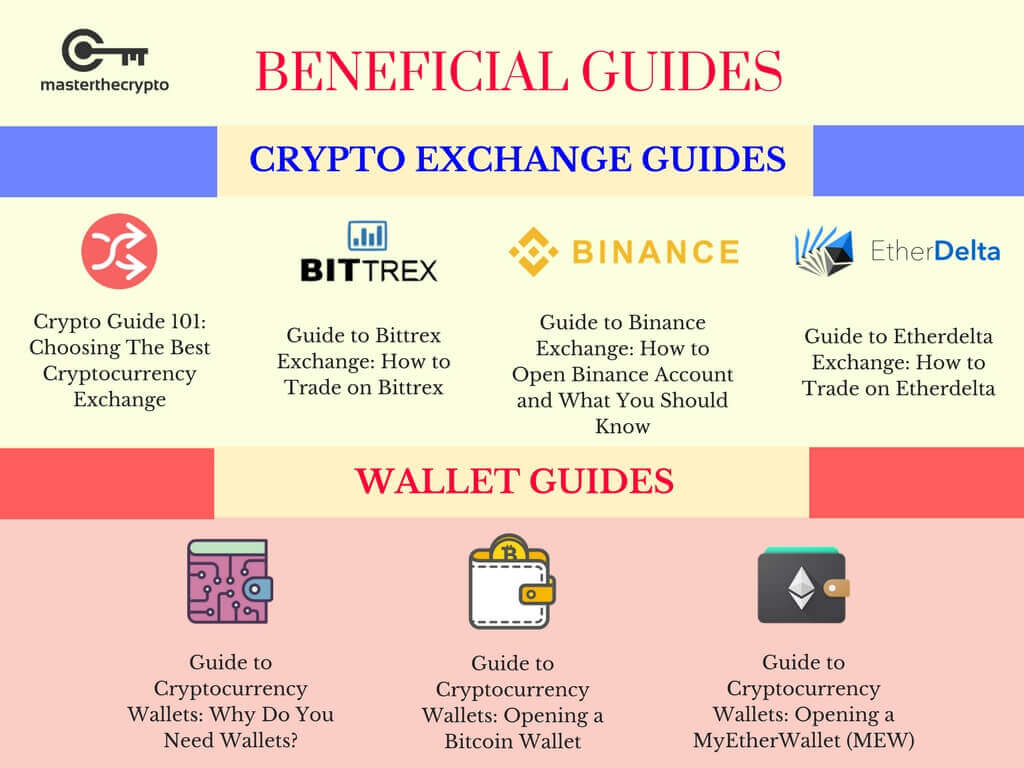 & Exchange
& Exchange
- Crypto Guide 101: Choosing The Best Cryptocurrency Exchange
- Guide to Bittrex Exchange: How to Trade on Bittrex
- Guide to Binance Exchange: How to Open Binance Account and What You Should Know
- Guide to Etherdelta Exchange: How to Trade on Etherdelta
- Guide To Cryptocurrency Trading Basics: Introduction to Crypto Technical Analysis
- Cryptocurrency Trading: Understanding Cryptocurrency Trading Pairs & How it Works
- Crypto Trading Guide: 4 Common Pitfalls Every Crypto Trader Will Experience
Wallets
- Guide to Cryptocurrency Wallets: Why Do You Need Wallets?
- Guide to Cryptocurrency Wallets: Opening a Bitcoin Wallet
- Guide to Cryptocurrency Wallets: Opening a MyEtherWallet (MEW)
Read also: Crypto Trading Guide: 4 Common Pitfalls Every Crypto Trader Will Experience and Guide To Cryptocurrency Trading Basics: Introduction to Crypto Technical Analysis.
Get our exclusive e-book which will guide you on the step-by-step process to get started with making money via Cryptocurrency investments!
You can also join our Facebook group at Master The Crypto: Advanced Cryptocurrency Knowledge to ask any questions regarding cryptos!

